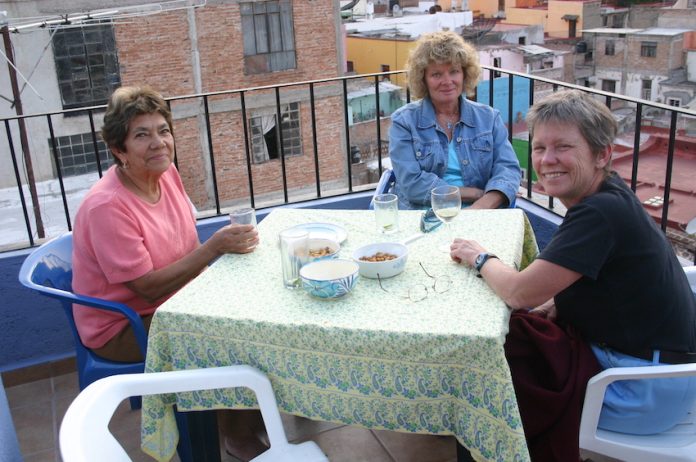I turned to the last page of “Yo no soy tu perfecta hija mexicana,” (I’m Not Your Perfect Mexican Daughter) by Erika L. Sánchez and closed the novel with a happy sigh. Mission accomplished!
Although the book was originally written in English, I read all 300 pages in Graciela Romero Saldaña’s Spanish translation, which is one way I’ve found to boost my fluency in Spanish.

I’ve had an advantage learning the language because when I was nine, my family lived in Quito, Ecuador, where I attended a bilingual school. When we returned to the United States, however, French was the de rigueur foreign language taught in schools, and so I didn’t study Spanish again until I was 16.
My Spanish-language education continued in a hopscotch, on-again, off-again style — taking classes when I traveled to Latin America, then letting it lapse for long periods — until my husband and I bought our Guanajuato home in 2005. Then I started getting serious about Spanish, working toward being able to engage at a deep level.
Here are six strategies that helped me achieve my goal:
1. Reading popular magazines
Years ago, during a break between classes at the Spanish school I was attending, I found a stash of magazines on a shelf, including Buen Hogar, the Spanish-language version of Good Housekeeping. Browsing through it, I discovered that I understood more than I’d expected.
Thus began my popular-magazine approach to learning Spanish.

Women’s magazines came first because they offered content I was familiar with. Worldwide, they all focus on health, fitness, homemaking, marriage, parenting and psychological topics. As a freelance writer, I’ve not only read these evergreen articles for years, I’ve written them myself!
I found the short articles the easiest — those divided by subtitles or organized with numbers, like “8 Ways to Make Your Home Sparkle at Christmas” and “6 Ways To Look Younger.”
2. Hiring tutors
In the early stages of studying Spanish, when I had to learn basic grammar and vocabulary, classroom structure was beneficial. But once I had the basics down, I found it more helpful to hire a tutor for individual sessions than to attend a class.
With a tutor, you can not only customize the material to your specific needs but you also get to build a personal relationship with your teacher. It’s also often more affordable because you’re not paying school administration fees.
3. Joining language exchange websites
I joined a free site called Conversation Exchange, where people chat with others around the world in order to practice a language.
Joining was easy: I created a profile, giving English as my native language and stating that I wanted to practice advanced Spanish. I filtered for age (over 40) but not for gender. Since then, I’ve had exchanges with people from Argentina, Peru, Costa Rica, Mexico and Spain.
4. Inviting people over

Whether we’re at our home or on the road, Barry and I like to invite people we meet over to our house or Airbnb or hotel for a drink. We’ve hosted fellow travelers, our Spanish teachers and their kids, our neighbors, the owners of the Airbnb where we’re staying and builders working on our house.
We rarely invite people for dinner. Our goal is to have casual, semi-spontaneous interactions, not formal and elaborate meals, so we keep it simple and serve soft drinks, beer, wine and a few easy snacks. We’ve found this a great way to practice Spanish, get to know folks and have fun.
5. Chatting with taxi and Uber drivers
When Barry and I travel around Mexico or other Latin American countries, we don’t rent a car, since we like to interact with locals. Instead, we prefer public transit, taxis and Uber. We find that drivers are often not only providers of helpful information but also great conversationalists.
To get started, we introduce ourselves and ask how their day is going; before long, we’re off.
We’ve had lively discussions about which areas to visit and which to avoid, the drivers’ spouses, siblings, kids, in-laws — you name it. One guy even told us that he had informed his wife after their third child was born that the “factory was closed” and that he was planning to have a vasectomy. You can see why these conversations often turn into the highlight of our day!

6. Offering my skills
Before Barry and I bought our home, we visited Guanajuato city several times. During one period, I learned from Juan Carlos, my Spanish tutor, that the University of Guanajuato had a degree program in Human Resources. In my business as a training consultant, I had worked closely with many HR managers who hired me to train their company’s staff.
Juan Carlos and I discussed the idea of giving a talk to Human Resources students on my experience working with HR professionals, offering an inside perspective they probably wouldn’t otherwise get.
He helped me figure out how to approach one of the department’s professors, who showed interest. I prepared a simple presentation, first in English, then translated it into Spanish. Finally, I spent several sessions with Juan Carlos going over the grammar and vocabulary.
Looking back, I’m amazed at my chutzpah. I didn’t even know the subjunctive tense yet! But two students even took me up on discussing their career plans one-on-one! My Spanish was good enough, and I was finding a way to interact with Mexicans and having fun doing it.
Since then, I’ve found many other ways to offer my skills.
I find Mexicans to be very forgiving of language errors. Even when I hear myself making a grammatical mistake, they don’t seem to mind. Frankly, their expectations are not very high when it comes to Americans speaking Spanish, and they’re delighted when they discover I can say more than buenos dias.
For me, even a simple conversation in Spanish is like a brisk walk in fresh air. It renews my energy, lifts my spirits and restores my confidence in the world.
Louisa Rogers and her husband Barry Evans divide their lives between Guanajuato and Eureka, on California’s North Coast. Louisa writes articles and essays about expat life, Mexico, travel, physical and psychological health, retirement and spirituality. Her recent articles are on her website, louisarogers.contently.com
